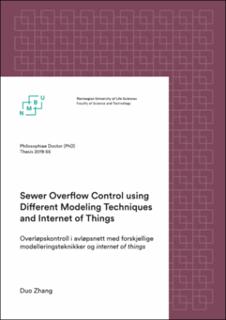| dc.description.abstract | Increased urbanization and extreme rainfall events are causing more frequent instances of sewer overflow, leading to the pollution of water resources and negative environmental, health, and fiscal impacts. At the same time, the treatment capacity of wastewater treatment plants is seriously affected.
The main aim of this Ph.D. thesis is to use the Internet of Things and various modeling techniques to investigate the use of real-time control on existing sewer systems to mitigate overflow. The role of the Internet of Things is to provide continuous monitoring and real-time control of sewer systems. Data collected by the Internet of Things are also useful for model development and calibration. Models are useful for various purposes in real-time control, and they can be distinguished as those suitable for simulation and those suitable for prediction. Models that are suitable for a simulation, which describes the important phenomena of a system in a deterministic way, are useful for developing and analyzing different control strategies. Meanwhile, models suitable for prediction are usually employed to predict future system states. They use measurement information about the system and must have a high computational speed.
To demonstrate how real-time control can be used to manage sewer systems, a case study was conducted for this thesis in Drammen, Norway. In this study, a hydraulic model was used as a model suitable for simulation to test the feasibility of different control strategies. Considering the recent advances in artificial intelligence and the large amount of data collected through the Internet of Things, the study also explored the possibility of using artificial intelligence as a model suitable for prediction.
A summary of the results of this work is presented through five papers. Paper I demonstrates that one mainstream artificial intelligence technique, long short-term memory, can precisely predict the time series data from the Internet of Things. Indeed, the Internet of Things and long short-term memory can be powerful tools for sewer system managers or engineers, who can take advantage of real-time data and predictions to improve decision-making.
In Paper II, a hydraulic model and artificial intelligence are used to investigate an optimal in-line storage control strategy that uses the temporal storage volumes in pipes to reduce overflow. Simulation results indicate that during heavy rainfall events, the response behavior of the sewer system differs with respect to location. Overflows at a wastewater treatment plant under different control scenarios were simulated and compared. The results from the hydraulic model show that overflows were reduced dramatically through the intentional control of pipes with in-line storage capacity. To determine available in-line storage capacity, recurrent neural networks were employed to predict the upcoming flow coming into the pipes that were to be controlled.
Paper III and Paper IV describe a novel inter-catchment wastewater transfer solution. The inter-catchment wastewater transfer method aims at redistributing spatially mismatched sewer flows by transferring wastewater from a wastewater treatment plant to its neighboring catchment. In Paper III, the hydraulic behaviors of the sewer system under different control scenarios are assessed using the hydraulic model. Based on the simulations, inter-catchment wastewater transfer could efficiently reduce total overflow from a sewer system and wastewater treatment plant. Artificial intelligence was used to predict inflow to the wastewater treatment plant to improve inter-catchment wastewater transfer functioning. The results from Paper IV indicate that inter-catchment wastewater transfer might result in an extra burden for a pump station. To enhance the operation of the pump station, long short-term memory was employed to provide multi-step-ahead water level predictions.
Paper V proposes a DeepCSO model based on large and high-resolution sensors and multi-task learning techniques. Experiments demonstrated that the multi-task approach is generally better than single-task approaches. Furthermore, the gated recurrent unit and long short-term memory-based multi-task learning models are especially suitable for capturing the temporal and spatial evolution of combined sewer overflow events and are superior to other methods. The DeepCSO model could help guide the real-time operation of sewer systems at a citywide level. | en_US |

